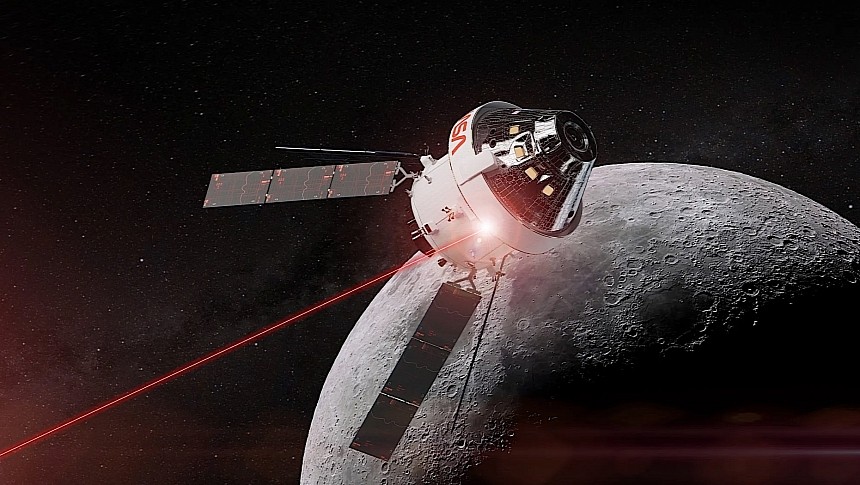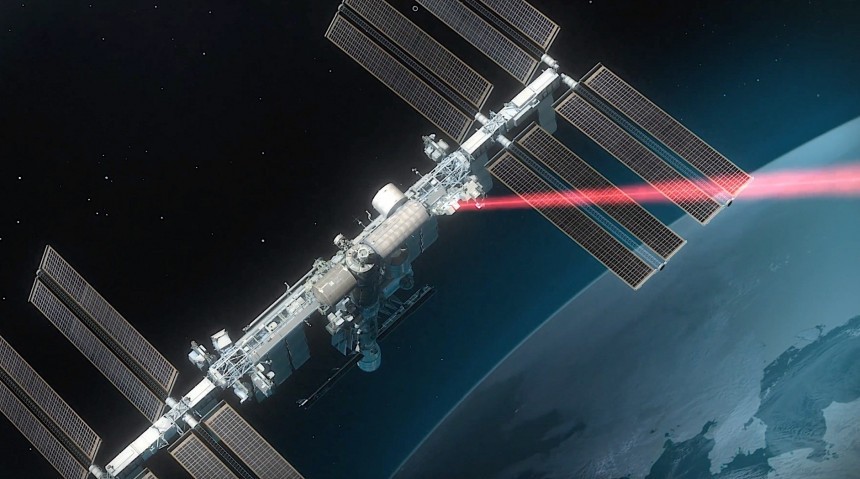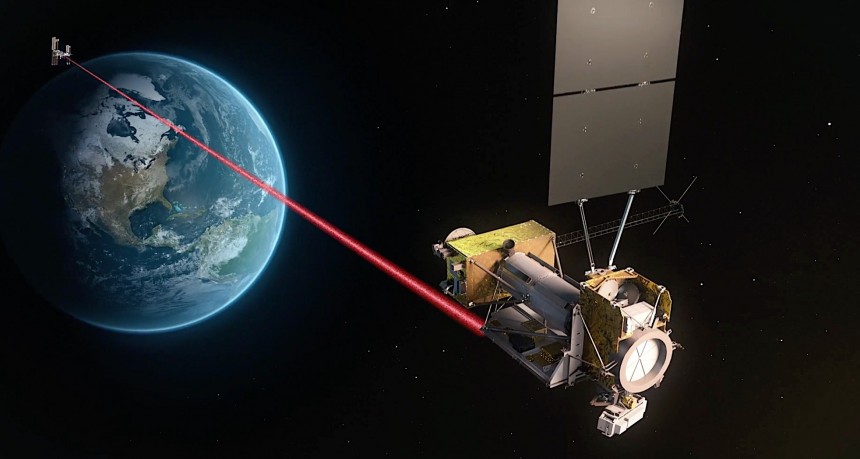Lasers are rapidly becoming the new promised land of space communications. Several times over the past few months, we've learned of different technologies being researched in this field, and their arrival has the potential to change the pace of space missions forever. Even if some of them are named like some sort of doomsday weapon.
The first major development in this field came back in the spring of last year when we learned of something called the TeraByte InfraRed Delivery (TBIRD). Launched with the Pathfinder Technology Demonstrator 3 (PTD-3) satellite in 2022, it was used to send back to Earth a staggering 200 gigabits of data per second, the "highest data rate ever achieved by optical communications technology."
Then, in August 2022, the American space agency announced a new piece of hardware called Low Earth Orbit User Modem and Amplifier Terminal (ILLUMA-T). Delivered to the International Space Station (ISS) as part of the 29th SpaceX resupply mission to the station, it was to beam high-resolution data, including pictures and videos, at a rate of 1.2 gigabits per second to a satellite called Laser Communications Relay Demonstration (LCRD).
From there, the same data would be forwarded down to Earth to receivers in Hawaii and California in what was to be the first run of America's "first two-way, end-to-end laser relay system." At the time of writing, however, we are unaware of the test having been concluded.
Finally, the end of 2023 brought with it news of a third system being test-fired. This one is called Deep Space Optical Communications (DSOC), and it is installed on the Psyche spacecraft.
DSOC was used to fire a laser beam at our planet from a distance of 10 million miles (16 million km) at a receiver at the Caltech Palomar Observatory in San Diego, California, which managed to catch it.
All these tests performed on laser communication technology are fueled by one thing and one thing only: the complexity of upcoming space missions. As we go deeper and bolder out into space, we'll need tech to help us communicate faster, more, and also navigate better.
As it stands humanity's space exploration efforts currently rely on radio technology to talk to spacecraft. It's a proven system that has been in use for decades, but it comes with two major limitations: it's not particularly fast, and it can be used to transmit only so much data.
Say, for instance, you'd want to transmit a rudimentary map of Mars to the people of our planet. You could very well do that using radio frequency tech, and it would take about nine weeks for all the data to be transmitted. By comparison, a laser system would do the same job in just nine days.
That's because lasers allow for more information to be packed into tighter waves, allowing receivers to get more data in a single transmission. In theory, lasers could be anywhere between ten and 100 times more efficient than the radio systems we currently use.
With that in mind NASA announced back in January it is backing a new optical comms tech developed by a company called Fibertek. Fearsomely named Basestation Optical Laser Terminal, it's a four-channel laser unit that may very well be tested during the Artemis II mission.
Currently scheduled to depart Earth in 2025 and take a crew of four people on a trip around the Moon, Artemis II has a good shot of using the Basestation as a test tool, allowing for "high-power communications to the Moon" during the flight.
The hardware is meant to enable the Orion spaceship to talk to Earth via laser and it is part of a wider system called Low-Cost Optical Terminal (LCOT). The low-cost part of its name is owed to the fact it was constructed using commercial off-the-shelf parts.
LCOT is actually a ground-based telescope with a diameter of just 27 inches (69 cm) and it is deployed at the Goddard Space Flight Center in Greenbelt, Maryland. If all the stars align it will be at the receiving end of high-resolution images and video of the Moon sent back by the crew of Artemis II.
Separately, NASA is planning to establish optical comms with the help of two other ground stations, located in White Sands, New Mexico, and Table Mountain, California.
Back to the LCOT, it and the Basestation it includes are for now just pre-prototype pieces of hardware. Funded through the agency's Space Communications and Navigation (SCaN) program, they have the potential to become the template for future ground stations.
We will keep an eye out for more developments on this front because it's clear NASA is betting heavily on lasers to expand the scope and reach of its future mission. And also because we all love lasers, especially when mounted on spaceships traveling through the void.
Then, in August 2022, the American space agency announced a new piece of hardware called Low Earth Orbit User Modem and Amplifier Terminal (ILLUMA-T). Delivered to the International Space Station (ISS) as part of the 29th SpaceX resupply mission to the station, it was to beam high-resolution data, including pictures and videos, at a rate of 1.2 gigabits per second to a satellite called Laser Communications Relay Demonstration (LCRD).
From there, the same data would be forwarded down to Earth to receivers in Hawaii and California in what was to be the first run of America's "first two-way, end-to-end laser relay system." At the time of writing, however, we are unaware of the test having been concluded.
Finally, the end of 2023 brought with it news of a third system being test-fired. This one is called Deep Space Optical Communications (DSOC), and it is installed on the Psyche spacecraft.
DSOC was used to fire a laser beam at our planet from a distance of 10 million miles (16 million km) at a receiver at the Caltech Palomar Observatory in San Diego, California, which managed to catch it.
As it stands humanity's space exploration efforts currently rely on radio technology to talk to spacecraft. It's a proven system that has been in use for decades, but it comes with two major limitations: it's not particularly fast, and it can be used to transmit only so much data.
Say, for instance, you'd want to transmit a rudimentary map of Mars to the people of our planet. You could very well do that using radio frequency tech, and it would take about nine weeks for all the data to be transmitted. By comparison, a laser system would do the same job in just nine days.
That's because lasers allow for more information to be packed into tighter waves, allowing receivers to get more data in a single transmission. In theory, lasers could be anywhere between ten and 100 times more efficient than the radio systems we currently use.
With that in mind NASA announced back in January it is backing a new optical comms tech developed by a company called Fibertek. Fearsomely named Basestation Optical Laser Terminal, it's a four-channel laser unit that may very well be tested during the Artemis II mission.
Currently scheduled to depart Earth in 2025 and take a crew of four people on a trip around the Moon, Artemis II has a good shot of using the Basestation as a test tool, allowing for "high-power communications to the Moon" during the flight.
LCOT is actually a ground-based telescope with a diameter of just 27 inches (69 cm) and it is deployed at the Goddard Space Flight Center in Greenbelt, Maryland. If all the stars align it will be at the receiving end of high-resolution images and video of the Moon sent back by the crew of Artemis II.
Separately, NASA is planning to establish optical comms with the help of two other ground stations, located in White Sands, New Mexico, and Table Mountain, California.
Back to the LCOT, it and the Basestation it includes are for now just pre-prototype pieces of hardware. Funded through the agency's Space Communications and Navigation (SCaN) program, they have the potential to become the template for future ground stations.
We will keep an eye out for more developments on this front because it's clear NASA is betting heavily on lasers to expand the scope and reach of its future mission. And also because we all love lasers, especially when mounted on spaceships traveling through the void.














